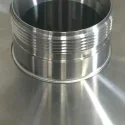- (TIG) Tungsten Inert Gas Welding
Tungsten Inert Gas Welding is the most commonly used welding method in sheet metal welding process. During the welding process, the tungsten electrode and the welding surface are used as electrodes, and helium or argon gas is blown into the two electrodes as a protective gas to protect the arc. The wire and base metal is melted through instantaneous high-voltage discharge to weld the aluminum alloy parts, and repair of casting defects in castings.
The technical features of Tungsten Inert Gas Welding:
- It is an easy, flexible, and controllable process, and adaptable to various working conditions and environments with low cost.
- The deformation is small and the overall performance of the joint is high.
- The welding process has good performance and stability, and the welds are dense and beautiful.
- (MIG) GMA-Gas Metal Arc Welding
Just like TIG, MIG also is inert gas-shielded welding. The difference between them is that TIG welding uses tungsten as the fixed electrode, while MIG welding uses the filled wire material itself as the electrode.
During the molten pole inert gas-shielded welding process of aluminum alloy, the voltage, and current act on the end of the welding wire electrode, generating an instantaneous high voltage between the welding wire electrode and the base metal, melting the base metal and the groove part, and the molten droplets at the end of the welding wire fall off vertically, after that the welding zone is formed.
MIG is faster than TIG. When welding large sheet metal parts, the welding movement range is small. By adjusting the wire feed speed, the welding efficiency can reach several meters per minute.
- Plasma arc welding
Plasma arc welding is a special form of arc. It is a high-density and energy arc and a gas-conductive phenomenon. Plasma arc welding is a method that uses the heat of the plasma arc to melt the workpiece and base metal to finish the welding work.
The characteristics of Plasma arc welding:
- Plasma arc with high energy density and strong penetration ability. During the welding, steel with a thickness of 10 to 12 mm does not need to be beveled and can be welded through on both sides at one time. It has fast welding speed, high productivity, and small stress deformation.
- The arc has good straightness and is less affected by arc length fluctuations and molten pool fluctuations.
- It uses small hole welding technology to achieve welding on a single side and double sides are both finished.
- Laser welding
Laser welding is a welding process that uses a laser beam focused by high-power monochromatic photon flow as a heat source. This welding method usually includes continuous power laser welding and pulse power laser welding.



